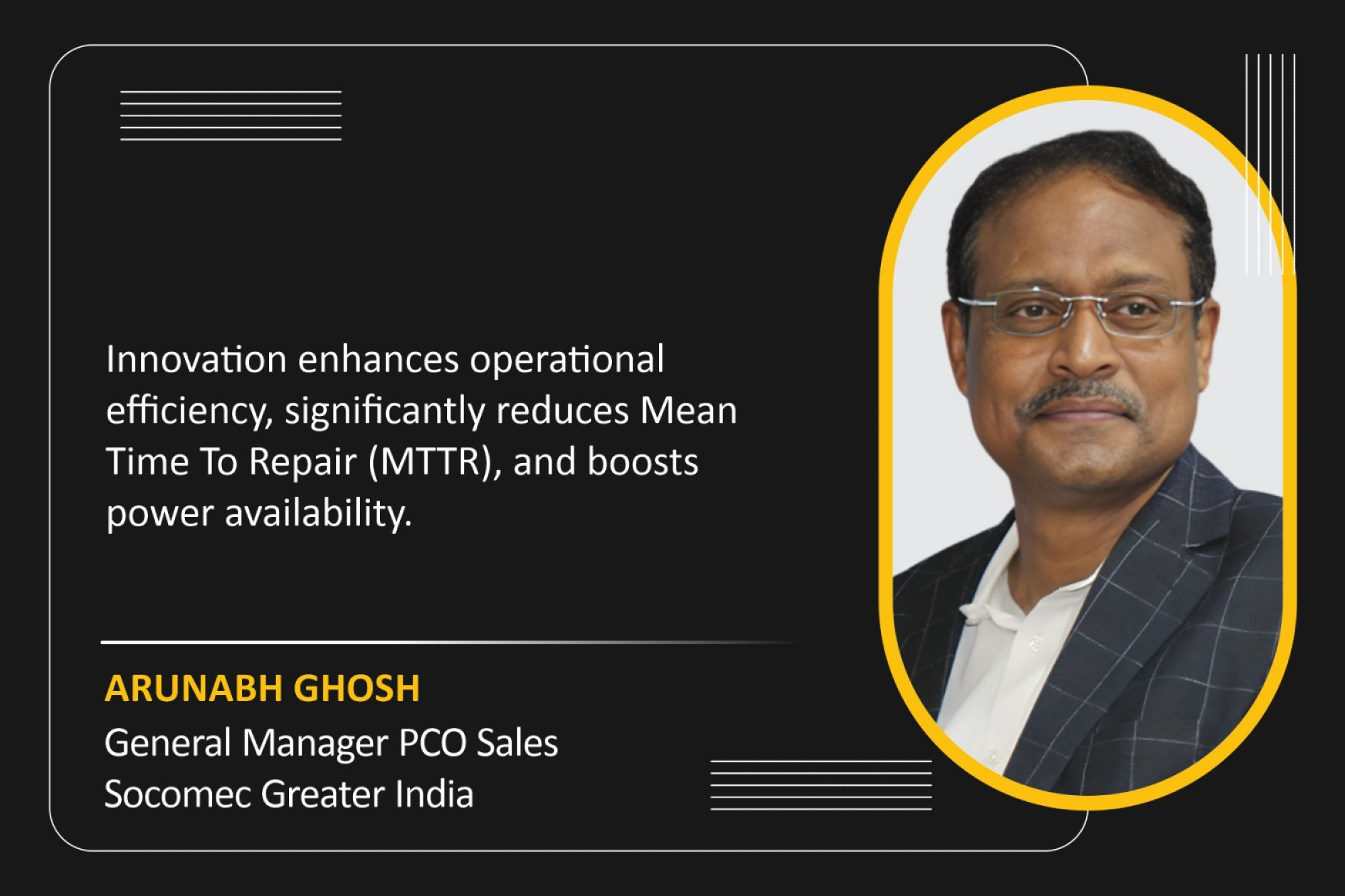Socomec remoteXpert technology transforming service delivery for UPS systems
By EPR Magazine Editorial November 18, 2024 10:50 am IST
By EPR Magazine Editorial November 18, 2024 10:50 am IST

Advanced monitoring capabilities enable data centres to optimise power usage while supporting sustainability goals. High-density UPS systems also pave the way for smarter, more efficient energy management in critical infrastructure.
Innovative UPS solutions with high power density, modular flexibility, and advanced monitoring enhance data centre efficiency, resilience, and sustainability. This supports critical infrastructure while reducing downtime and optimising energy management, ultimately leading to energy security. Let us know more from Arunabh Ghosh.
How do high-density UPS systems enhance operational efficiency in data centres?
As a pioneer in the power management industry, we observe that the latest technology in UPS systems features high power density solutions that combine a compact footprint with the reliability of traditional monolithic designs and the flexibility of modular architectures. This innovation enhances operational efficiency, significantly reduces Mean Time To Repair (MTTR), and boosts power availability. By integrating internal redundancy, these systems ensure a continuous power supply and minimise downtime, making them ideal for data centres. Additionally, advanced monitoring capabilities facilitate effective energy management, enabling data centres to optimise power usage while supporting sustainability goals. These UPS solutions pave the way for smarter, more efficient energy management in critical infrastructure.
How do innovative distribution models enhance data centre resilience and sustainability?
Innovative distribution models like 3N2, 4N3, and 5N4 are increasingly achievable in balancing the need for a resilient data centre while minimising its carbon footprint. In these configurations, backup capacity is mutualised, allowing each system to actively support the others. This approach significantly reduces the required installed power for transformers, UPS, and batteries—by 1.5 times for 3N2 and 1.33 times for 4N3, for example.
Additionally, the Catcher system employs a single shared backup for all active or priority systems rather than having each system back up the others. Many mid to large-sized data centre operators are now adopting high-power density UPS solutions, such as 1 MW/1.2 MW in a single unit. This trend decreases UPS’s physical footprint and reduces its overall infrastructure footprint, positively impacting capital expenditures (CAPEX) and operational expenditures (OPEX) and contributing to sustainability goals.
How do intelligent UPS modes enhance energy efficiency and reliability in data centres?OEMs and data centre infrastructure solution providers are collaborating to create innovative solutions to comply with the 2023 Best Practice Guidelines for the EU Code of Conduct on Data Centre Energy Efficiency, particularly for facilities with a capacity of ≥ 1 MW. This compliance ensures adherence to high-efficiency elite standards for UPS systems and aligns with sustainability goals. Additionally, the intelligent operating mode concept in UPS allows for load protection in both online double and smart conversion modes, achieving an impressive efficiency of 99.1 percent with instantaneous Class 1 transfer by IEC 62040-3 standards. This enhances critical infrastructure reliability, reducing downtime risks and safeguarding operations.
Customers benefit from improved energy efficiency, which lowers operational costs and enhances overall power usage effectiveness (PUE) in data centres, all without compromising power availability for sensitive IT loads. Additionally, the flexibility and scalability of these intelligent modes allow customers to adapt to changing load demands, ultimately reducing capital and operational expenditures.
How does Socomec remoteXpert technology transform service delivery for UPS systems?
Digital innovation significantly reduces waiting times, minimises downtime risks, lowers carbon emissions, and optimises global asset management costs in the maintenance sector of data centres. Manufacturers must ensure that remote access is secure while blending human expertise with IoT and connected technologies. This shift encourages customers and manufacturers to rethink service delivery, fostering a more sustainable approach that reduces travel distances, lessens traffic impact, and enhances safety.
All remote connections must adhere to cybersecurity protocols for products and IoT infrastructure, following IEC 62443 and ISO 27001 standards. Our MODULYS XM series, available in configurations of 250 kW + 50 kW redundancy and 600 kW + 50 kW redundancy, is designed for a lifespan exceeding 20 years, embodying the “Forever Young” concept. This design allows for the seamless integration of modules and components with guaranteed compatibility for over 20 years, and its parts are easy to recycle, reflecting an eco-design philosophy.
Additionally, our products feature remote troubleshooting technology, enabling Socomec experts to conduct diagnostics and tests with zero transport-related carbon emissions. API technology facilitates integration with existing digital platforms and promotes efficient data exchange. These advancements showcase our commitment to empowering customers by optimising asset management, extending asset lifespan, and ensuring maximum return on investment. The patented Socomec remoteXpert technology transforms service delivery, moving away from traditional field interventions for UPS systems.
We use cookies to personalize your experience. By continuing to visit this website you agree to our Terms & Conditions, Privacy Policy and Cookie Policy.